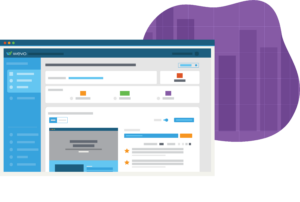Contents
Are you worried that your website has an outdated UI? If so, it might be well past the time for a user interface update. An out-of-date website user interface can have negative repercussions that expands well beyond the digital realm to affect everything from customer service to profitability.
This being said, what does an outdated UI look and feel like and what are the next steps required to get to an updated user interface? Let’s break it down.
Obsolete Web Design
There are plenty of outdated website examples still out there that make it look like the designers stepped out of a time machine from the 90s. But what makes these sites look and feel outdated?
Some of the worst offenders for outdated web design elements include:
- Highly complex navigation with too many features
- Clashing or bright colors
- Frames and tables (which have since been superseded by the <div> tag)
- Blinking, scrolling, or animated text
- Intrusive pop-up windows
These days, websites need to be fast, beautiful, and responsive. On top of this, they need to be accessible from a variety of devices – including desktops, laptops, tablets, smartphones, and more. Clinging to a years-old design for your website is holding you back from reaching all of these objectives.
Keep Reading: 3 user research methods and how they work
Other Team Members Are Shouldering the Load
Your website needs to be the first point of contact for your business, making it easy for customers and prospects to get the information you need. However, if your audience can’t successfully achieve their goals, then this will hurt the user experience. As a result, the burden will fall on other teams such as sales and customer service.
For example, if buyers are struggling to find products on your website, they might need to have a call or live chat with customer support to help them through the checkout process. Meanwhile, if valuable white papers and ebooks are hidden away behind layers of navigation, this could harm your conversion rates, and your sales team might have to distribute these materials manually.
You’re Stuck Patching Holes
Along with your social media pages, your website should be the face of your business online, demonstrating your ability to constantly innovate and move forward. If you’re still using an outdated UI design, prospective customers may question (either consciously or subconsciously) your commitment to growing alongside them.
These prospects’ suspicions may indeed be correct if your web design team is spending more time maintaining the site and fixing leaks than building new features. Without enough bandwidth to focus on the future, web designers will be constantly looking back at the past and struggling to remain relevant as your competitors zoom by.
Keep Reading: User research’s battle against dark UX
What are the next Steps for updating an outdated UI?
After reviewing clear-cut signs of an outdated UI, are you starting to second-guess your own site? If so, it likely means it’s time for a refresh, and realizing this fact is the first step of many.
Ask yourself the following:
- What kind of changes need to be made to the website? Will it be a purely cosmetic upgrade, or does there need to be a serious restructuring of the site hierarchy?
- What are the positive impacts we are hoping to achieve for the rest of the business with this redesign (e.g. greater profitability, shorter sales processes, higher conversion rates, etc.)?
- What are the metrics and KPIs (key performance indicators) by which we can judge the success of a website update?
With answers to these questions, you can move on to the following:
- Gathering data: A data-driven approach is tremendously valuable when redesigning an outdated UI. By collecting information about how real users interact with your website, you can better understand which elements need to be optimized or eliminated.
- Building a strategy: Your website UI will ultimately affect everyone in the company, so it’s essential that all key decision-makers are on board. Start creating an implementation strategy and timeline that discusses the target audience, the new features, and the plans for rolling out the update.
- Finding the right partner: Without the in-house resources necessary for this project, you’ll need to find a web design partner with the skills and experience that suit your website goals. The right partner will be able to work with you throughout the project lifecycle, from planning and road mapping to long-term support and maintenance.
Keep Reading: What does democratized knowledge mean?
Are you ready for a user interface update?
If you’ve never done a user interface update before, or you don’t have the right in-house web designers and other staff available, it’s a wise idea to get some outside help. The first step to updating your old UI design is to understand the problems and pain points that real users are having with your website.
That’s exactly what the WEVO user experience platform was designed for. Using real people in your target audience, WEVO conducts in-depth UX research about your website and then delivers the results in a clear, easy-to-use analytics dashboard.
Want to learn more about how WEVO can help optimize your user interface? Get in touch with us today for a chat about your business needs and objectives.



